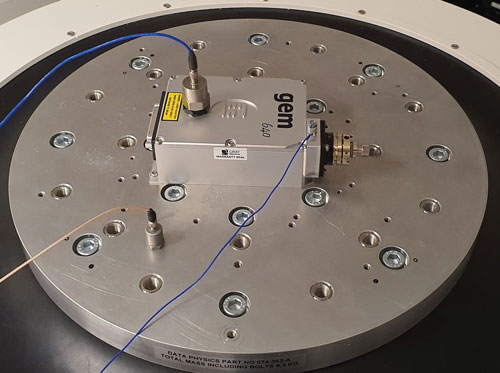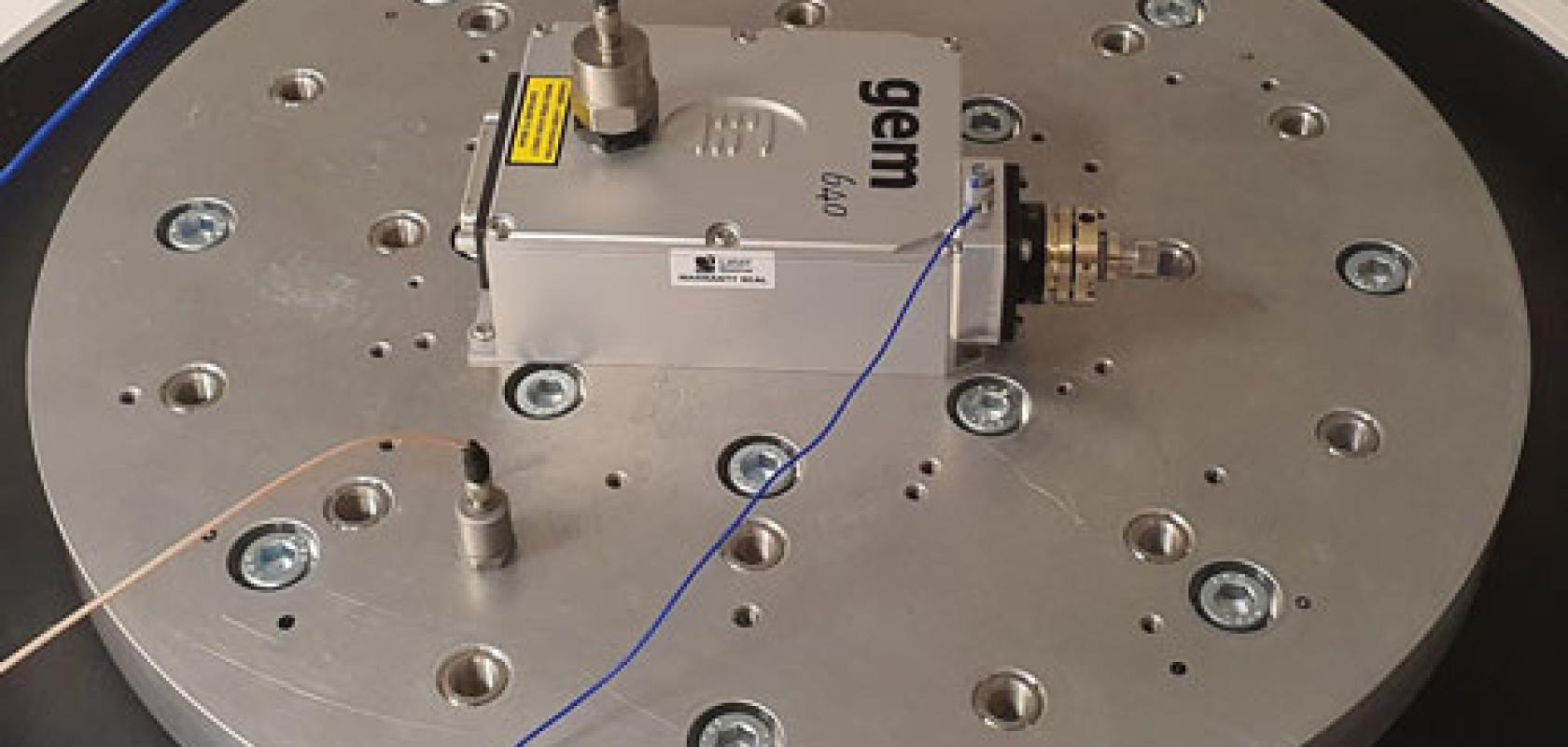Fibre coupling is an established and valuable technique used in many of today’s laser systems. Here, the laser beam is coupled into a fibre to transport the beam light in a safe manner.

Gem laser with attached fibre on a vibration test plate
Beam quality is often improved as a result of efficient fibre coupling. For example, a laser diode usually delivers an elliptical beam shape. Using an efficient fibre coupling design, the output beam shape is circularised into a round beam profile. Coupling the light beam into a single-mode fibre also has the benefit of enabling side modes of the diode to be filtered, resulting in a near TEM00, Gaussian beam profile.
However, depending on the beam quality of the laser coupling to the single-mode fibre, the fibre coupling itself often results in high losses in optical output power. This power loss can be reduced by multimode fibre coupling, but this can introduce further major technical challenges into the system later down the beam path.
Gregor Klatt, business development manager at Novanta, explained the differences between the single-mode and multimode coupling systems. He said: ‘The main difference is the area or volume which really is guiding the light. In a single mode fibre, only one single transverse mode, the ‘fundamental transverse mode’ labelled as TEM00 mode, can propagate. The TEM00 mode has the same form as a Gaussian beam.’
Klatt added: ‘In contrast, in a multimode fibre, many modes exist and propagate. This becomes important when the light is coupled from the fibre to free space again, since only the light out of a single mode fibre can be focussed to a diffraction limited spot (again) – something that is not possible with multimode fibres’.
Novanta develops high-performance photonic components and sub-systems for OEMs in diagnostic, analytical, micromachining and fine materials applications. Novanta’s advanced laser group specialises in developing and manufacturing high-reliability DPSS lasers and light engines designed for integration into high-performance instruments and systems across these sectors.
Together with its world-class laser manufacturing facility, Novanta offers scalable high-volume OEM laser design and build in addition to a comprehensive software and firmware development capability enabling fully customisable beam and pulse control.
In its latest whitepaper, Novanta explains how its advanced laser group is now able to offer single-mode fibre coupled systems with the combined benefits of an exceptionally high coupling efficiency of up to 80 per cent, for visible lasers up to 3W input powers in the visible range.
The white paper addresses two key challenges facing the development of single-mode fibre coupled systems. Klatt explained: ‘A primary challenge for us was to reach far higher coupling efficiencies than those previously achieved. During this development we actually managed to reach coupling efficiencies approaching 80 per cent, so we are delighted to be able to offer our customers a guaranteed minimum 70 per cent coupling efficiency across our entire wavelength range.’
Klatt added: ‘The second big challenge was for us to see how much power we could actually get in (and out!) of the fibre. With this new capability, we are now able to offer our customers high power fibre coupling up to 3W across our entire wavelength range (473, 532, 561, 640, 660, 671 and 1,064) This represents a 10-fold increase in maximum power coupling compared to the current industry standard.’
Good coupling efficiency requires the precise positioning of the fibre to centre the core in the focused laser beam. Multimode fibres usually have large cores and can achieve good coupling efficiencies relatively easily with standard lenses. However, due to their very small core diameter of only some microns, single-mode fibres require more elaborate couplers with submicron positioning resolution.
In the white paper, Novanta reveals how it has created a plug-and-play single-mode fibre coupling system that does not require continual realignment. The mechanical stability and reliability was exceptionally high.
Unlocking applications
There are many scenarios where a near-perfect TEM00 beam profile is required. Klatt explained: ‘All applications requiring tight focussing can only utilise single mode fibres, or they need to stick to free space lasers. For example, a lot of microscopy techniques, especially super resolution microscopy, require single mode fibre coupling because of either tight focussing or exotic beam shaping.’
For example, fibre-coupled microscope systems typically use single-mode fibres to deliver light from the laser to the microscope. Confocal microscopy is a key application area where the aim is to suppress the light from out-of-focus planes using a point illumination in the focal plane and by using a pinhole in the detection beam path. Fibre coupling is often employed in these confocal microscopy setups where the coupling of a laser diode head into a polarisation-maintaining single-mode fibre is a key requisite.
Klatt added: ‘Another application not apparent at first glance is modulation with the help of acousto-optic-modulators (AOM) or acousto optic tuneable filters (AOTF) since fibre coupled devices achieve higher speeds.’
In an AOM, a laser beam interacts with a high-frequency sound wave, usually including an optically polished glass or crystal block. By orienting the laser beam with the sound waves, the beam reflects off the acoustic wavefronts. So, when a sound field is present, the beam is deflected, allowing you to then modulate the beam.
That’s not the only application area for single-mode optical fibres. Klatt added: ‘Finally, applications that are sensitive to beam pointing variations benefit from single mode fibre coupling since any minor vertical drift with changing temperatures or power levels is eliminated due to the fact the fibre coupler with the attached fibre will follow the move in any direction.’
In the whitepaper, the team also provides details of a 45-hour coupling efficiency test at a constant temperature and another 30-minute vibration test. There were no fluctuations visible, demonstrating that the laser and fibre coupling arrangement used was also mechanically extremely stable.
The effect on the coupling efficiency with changing laser temperature was also monitored. Again, the system delivered exceptional results in this regard – find out more about this work in Novanta’s whitepaper, High power single-mode fibre coupling.’
Klatt concluded: ‘Novanta is delighted through its long heritage in designing high-performance laser sub systems to have applied its deep knowledge in this area to developing a unique fibre coupling solution that enables high power DPSS lasers to be fibre coupled with exceptionally high coupling efficiencies.’
If you'd like to learn more on this topic please feel free to download a White Paper here.


